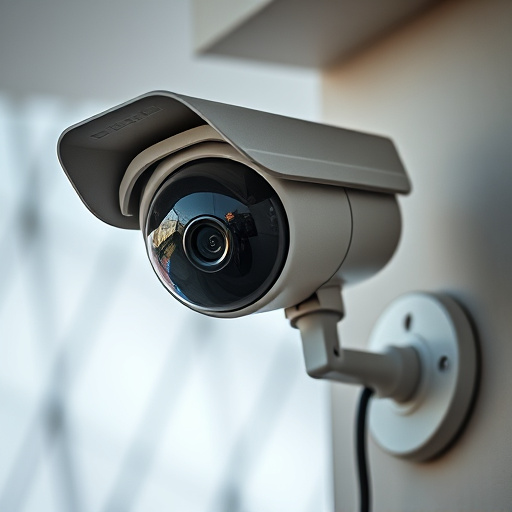Strategic placement of realistic fake CCTV cameras enhances security by deterring criminals through the illusion of constant surveillance, particularly in high-crime areas like parks and shopping centers. However, their use must balance deterrent effectiveness with legal, ethical, and public trust considerations, requiring proper authorization, disclosure, and transparency to maintain community trust. High-quality decoys maximize their effectiveness when strategically positioned and accompanied by realistic decoy sensors or alarm signs.
In today’s digital age, security monitoring is a top concern for businesses and homes alike. However, the proliferation of fake CCTV cameras has raised questions about their deterrent effectiveness. This article explores the strategic placement of these devices to deter crimes, delving into psychological studies, real-world impact, legal considerations, and ethical implications. We also provide practical guidance on choosing and setting up authentic-looking false surveillance gear, shedding light on how to enhance security without relying solely on genuine CCTV cameras.
- Understanding Fake CCTV Camera Placement for Deterrence
- The Psychology Behind Visual Deterrents' Effectiveness
- Analyzing Real-World Studies on Fake Cameras' Impact
- Legal Considerations and Ethical Implications of Using Fakes
- Choosing and Setting Up Authentic-Looking False Surveillance Gear
Understanding Fake CCTV Camera Placement for Deterrence
The placement of fake security monitoring devices, specifically fake CCTV cameras, plays a pivotal role in their deterrent effectiveness. Strategically positioning these decoys can significantly enhance overall security. Criminals are often deterred from attempting illicit activities when they encounter clearly visible fake cameras, assuming that real surveillance is in place.
In addition to obvious placement near entry points and high-value assets, clever use of lighting and realistic aesthetics further increases their deterrent impact. Well-lit areas with strategically placed fake cameras can create an illusion of constant observation, thereby discouraging potential criminals from targeting the area. This simple yet effective measure contributes to creating a safer environment by misleading would-be intruders.
The Psychology Behind Visual Deterrents' Effectiveness
The sight of a fake CCTV camera can significantly impact an individual’s behavior, highlighting the power of visual deterrents in security measures. Human beings are inherently visual creatures, and our brains process images quickly, often subconsciously. A well-placed dummy camera tricks the mind into believing that it is being watched, fostering a sense of awareness and potentially discouraging criminal activity. This psychological effect is particularly effective because it appeals to our natural tendency to avoid being observed, a concept known as the “watchful eye” phenomenon.
The effectiveness of fake CCTV cameras lies in their ability to manipulate people’s perceptions and create an illusion of constant surveillance. Research suggests that even when individuals know they are not real, these dummy devices can deter crimes due to the fear of exposure and potential consequences. This strategy leverages the power of suggestion and visual cues, making it a valuable tool for enhancing security without relying solely on physical presence or advanced technology.
Analyzing Real-World Studies on Fake Cameras' Impact
Numerous real-world studies have explored the deterrent effect of fake security monitoring devices, particularly fake CCTV cameras. These studies offer valuable insights into how the mere presence of such decoys can impact crime rates in various settings. Research suggests that strategically placed fake cameras can significantly deter potential criminals from targeting areas they perceive as well-monitored. This is especially true in public spaces like parks, streets, and shopping centers where visible surveillance has been shown to reduce incidents of vandalism, theft, and even violent crimes.
However, the effectiveness of fake CCTV cameras varies based on several factors. These include the quality and realism of the decoy devices, their placement, and the surrounding environment’s crime levels. Studies have found that high-definition, lifelike fake cameras installed in areas with a history of criminal activity can yield more substantial results than low-quality alternatives. Moreover, their impact might be further enhanced when combined with genuine security measures, demonstrating that while fake cameras alone may not stop all crimes, they can serve as an effective deterrent and part of a comprehensive security strategy.
Legal Considerations and Ethical Implications of Using Fakes
The use of fake security monitoring devices, such as non-functional CCTV cameras, raises a series of legal and ethical questions. While these decoys can serve as effective deterrents for potential criminals due to their visible presence, they also pose challenges in terms of privacy rights and law enforcement accountability. In many jurisdictions, there are strict regulations regarding surveillance technology, and deploying fake cameras without proper authorization or disclosure could lead to legal consequences.
Ethically, the placement of these devices must consider public trust and transparency. Using fake security setups may create a false sense of safety for some while potentially infringing upon others’ privacy, especially if not clearly marked as simulations. It’s crucial for property owners and businesses to understand local laws and ensure they are utilizing such deterrents responsibly, balancing the deterrent effect against individual freedoms and community trust.
Choosing and Setting Up Authentic-Looking False Surveillance Gear
When creating a fake security monitoring device setup, selecting authentic-looking gear is paramount to achieving a credible deterrent effect.
Invest in high-quality fake CCTV cameras that mimic real models in terms of design, size, and placement. These should be placed at strategic points around your property, offering the illusion of comprehensive surveillance. Additionally, consider incorporating other realistic elements like decoy sensors or signs indicating an alarm system is active to enhance the overall realism and deter potential intruders.
The strategic placement of fake security monitoring devices, or fake CCTV cameras, can serve as a powerful deterrent against crime. By understanding the psychological impact and analyzing real-world studies, we recognize their potential to significantly enhance safety without incurring the costs and ethical dilemmas associated with extensive surveillance systems. When choosing and setting up these authentic-looking false gear, it’s crucial to balance effectiveness with legal considerations, ensuring their responsible use in deterring criminal activity while preserving privacy rights.
